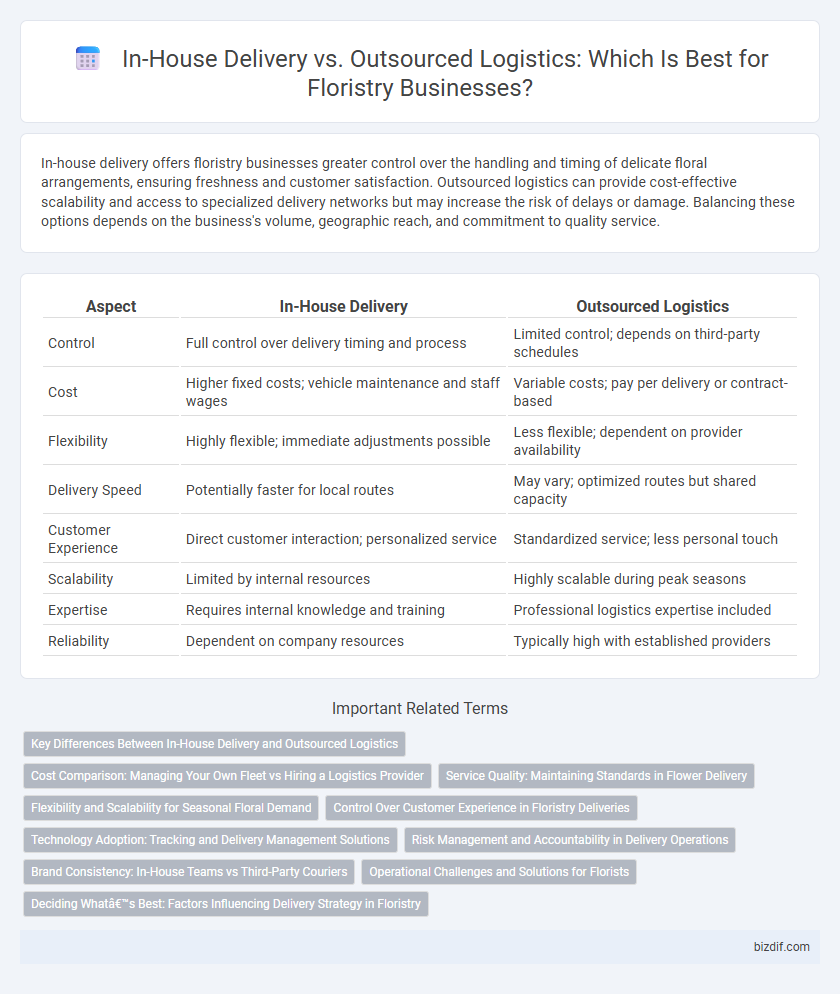In-house delivery offers floristry businesses greater control over the handling and timing of delicate floral arrangements, ensuring freshness and customer satisfaction. Outsourced logistics can provide cost-effective scalability and access to specialized delivery networks but may increase the risk of delays or damage. Balancing these options depends on the business's volume, geographic reach, and commitment to quality service.
Table of Comparison
| Aspect | In-House Delivery | Outsourced Logistics |
|---|---|---|
| Control | Full control over delivery timing and process | Limited control; depends on third-party schedules |
| Cost | Higher fixed costs; vehicle maintenance and staff wages | Variable costs; pay per delivery or contract-based |
| Flexibility | Highly flexible; immediate adjustments possible | Less flexible; dependent on provider availability |
| Delivery Speed | Potentially faster for local routes | May vary; optimized routes but shared capacity |
| Customer Experience | Direct customer interaction; personalized service | Standardized service; less personal touch |
| Scalability | Limited by internal resources | Highly scalable during peak seasons |
| Expertise | Requires internal knowledge and training | Professional logistics expertise included |
| Reliability | Dependent on company resources | Typically high with established providers |
Key Differences Between In-House Delivery and Outsourced Logistics
In-house delivery in floristry offers greater control over order handling, ensuring fresh and timely flower arrangements, while outsourced logistics rely on third-party carriers that may not specialize in delicate floral products. Cost structures differ significantly; in-house operations require investment in vehicles and staff, but enable customized delivery schedules, whereas outsourcing reduces fixed expenses but may sacrifice some flexibility and quality assurance. The key difference lies in the balance between control and scalability, with in-house delivery prioritizing direct management and outsourced logistics emphasizing broader distribution capabilities.
Cost Comparison: Managing Your Own Fleet vs Hiring a Logistics Provider
Managing an in-house delivery fleet in floristry involves expenses such as vehicle maintenance, fuel, driver wages, and insurance, which can significantly increase operational costs. Outsourcing logistics to a specialized provider often converts these fixed costs into variable costs, offering scalability during peak floral seasons and reducing overhead. Cost comparison analyses reveal that while in-house delivery may suit high-volume businesses with consistent demand, hiring a logistics provider typically minimizes total expenses for small to medium florists with fluctuating order volumes.
Service Quality: Maintaining Standards in Flower Delivery
In-house delivery guarantees stringent control over flower handling, ensuring freshness and timely arrivals by directly managing staff training and route optimization. Outsourced logistics may face variability in service quality due to diverse handling practices and less direct oversight, potentially compromising the delicate nature of floral products. Prioritizing consistent service standards through in-house delivery often results in higher customer satisfaction and stronger brand reputation in the floristry industry.
Flexibility and Scalability for Seasonal Floral Demand
In-house delivery offers florists greater flexibility to adjust routes and schedules in real time, accommodating the fluctuating volumes typical of seasonal floral demand. Outsourced logistics provide scalable resources, enabling rapid expansion during peak seasons without the overhead costs of maintaining a permanent delivery fleet. Balancing in-house agility with outsourced scalability ensures optimal service levels and cost efficiency throughout varying demand cycles.
Control Over Customer Experience in Floristry Deliveries
In-house delivery in floristry ensures complete control over the customer experience, allowing florists to maintain strict quality standards and timely handling from order to doorstep. Outsourced logistics may introduce variability in service quality, risking delays or mishandling that can negatively impact fresh flower presentation and customer satisfaction. Maintaining delivery operations internally helps florists preserve brand reputation and personalize delivery interactions, which are critical in the sensitive floristry market.
Technology Adoption: Tracking and Delivery Management Solutions
In-house delivery in floristry allows businesses to implement customized tracking and delivery management solutions tailored to specific operational needs, enhancing real-time order updates and customer satisfaction. Outsourced logistics providers often utilize advanced, scalable technology platforms that offer comprehensive tracking capabilities and route optimization, reducing delivery times and operational costs. Integrating technology adoption in both models improves accuracy, transparency, and efficiency, directly impacting the freshness and timely arrival of floral products.
Risk Management and Accountability in Delivery Operations
In-house delivery in floristry offers greater control over risk management and ensures direct accountability for handling delicate arrangements, reducing damages during transit. Outsourced logistics may introduce variable risk factors due to third-party handling, potentially compromising the quality and timeliness of floral deliveries. Effective risk mitigation in floristry depends on transparent accountability protocols and consistent monitoring, which are more robust in in-house delivery operations.
Brand Consistency: In-House Teams vs Third-Party Couriers
In-house delivery teams maintain tighter control over brand consistency through direct training and oversight, ensuring floral arrangements and packaging align with company standards. Third-party couriers often have varying service protocols that can lead to inconsistent customer experiences and potential damage to floral products. Prioritizing in-house logistics enhances real-time quality assurance, crucial for preserving brand reputation in the competitive floristry market.
Operational Challenges and Solutions for Florists
In-house delivery offers florists greater control over handling and timely arrangements, but it faces operational challenges like staffing, vehicle maintenance, and route optimization. Outsourced logistics relieve the burden of managing delivery fleets and provide scalability, yet risks include inconsistent service quality and reduced control over customer experience. Implementing real-time tracking systems and establishing clear service level agreements can help florists balance efficiency and reliability across both delivery models.
Deciding What’s Best: Factors Influencing Delivery Strategy in Floristry
Choosing between in-house delivery and outsourced logistics for floristry hinges on factors like cost efficiency, service quality, and control over the delivery process. In-house delivery offers direct oversight and customization options, enhancing customer satisfaction for delicate floral arrangements. Outsourced logistics, meanwhile, provides scalability and access to broad distribution networks, crucial for florists managing high volumes or expanding markets.
In-house delivery vs outsourced logistics Infographic

 bizdif.com
bizdif.com